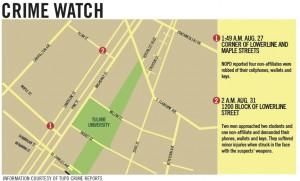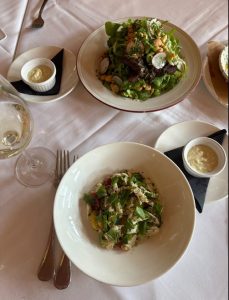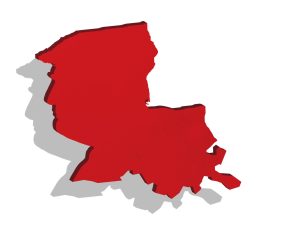No headline provided

September 5, 2011
Two armed robberies occurred within minutes of each other in theearly morning hours of Aug. 27 on Lowerline Street.
In the first incident, two men approached four peopleunaffiliated with Tulane at 1:49 a.m. on the corner of MapleStreet, showed their weapons and took their cellphones, wallets andkeys. Ten minutes later, the same men approached three people, twoof whom were Tulane students, walking into a residence on thecorner of Plum Street. The men hit each of the three victims in thehead with pistols and demanded their personal belongings. None ofthe victims were seriously injured.
Senior Jacob Tupper, who was mugged in the later incident, saidhe did not feel like his life was in danger, even as the robberpointed a pistol at his head.
“I wasn’t scared about getting shot or anything,” Tupper said.”It wasn’t personal. He was just like, ‘Give me your wallet.’ Whatwas strange was we were three guys over six feet tall walking downLowerline in a group. We were not a target.”
Tupper said he had seen TUPD patrol cars that night in the areaprior to the incident.
TUPD increases security
TUPD Police Chief John Meunier said TUPD increased its presencein the area the night of the crime. He added that every resource atTUPD’s disposal was in the field patrolling.
TUPD has two units that patrol campus nightly, and on weekends,it hires off-duty NOPD cars to patrol the area around the Uptowncampus. Additionally, the department pulls cars away from itsDowntown campus to the Uptown area on Saturday and Sunday nights.Meunier said the cars were patrolling the night of the incident andwill continue to do so every weekend.
“We didn’t wait for an incident this year to increase [TUPD]police presence,” Meunier said. “The neighborhood was virtuallysaturated [with police presence] Friday night. Not only by what[TUPD] did, with the added personnel that we put on, but NOPD hadindependent operations that they were doing that resulted inincreased police presence in the neighborhood.”
The chief said that NOPD had cars patrolling in the Uptown areaseparate from TUPD’s operations. The neighborhood association andMaple Street bars recently began paying for an off-duty NOPD car topatrol the Maple corridor, splitting the cost of the extrapatrol.
“There is an NOPD marked uniform police presence in thatspecific area that did not exist last year,” Meunier said.
Tulane Police Captain Reid Noble said that TUPD cannot placeblue light emergency poles on Maple Street because it is publicproperty. She said it would be illogical for TUPD to maintain apermanent presence on Maple Street, such as the police kiosk TUPDoperates outside The Boot, because it would take a car away fromregular patrols.
“We have patrols in all manners,” Noble said. “Constant patrolsdeter crime in all areas. If we put one [car on Maple permanently],it takes a car out from the field. It makes no patrol sense.”
Chief Meunier said that regardless of the added patrols, crimewill occur.
“Even though we have increased frequency [of patrolling units]and personnel from both our department and NOPD in that area, asyou can see from this [incident], things happen,” Meunier said. “Apatrol goes by a couple minutes before the robbery, the robberyoccurs, and before it’s reported another patrol goes by.”
SafeRide Changes
Meunier said to reduce crime, students should call SafeRide,which implemented a number of changes last semester to increaseproductivity.
TUPD added a SafeRide shuttle to its fleet last semester. Withthree buses in circulation every night, TUPD hopes to cut down onthe number of students walking home. SafeRide also started acallback service so that students can stay inside the bar,residence or other location from which they called until theshuttle arrives, Col. Jack Leblanc said.
“The driver is told to wait,” Leblanc said. “We are gettingcallback numbers now to give [the students] a call back. We want tomake that pick-up because we don’t want to have to go back thereagain. I’d rather invest one minute or two minutes sitting there,doing a callback, rather than leaving and [having] to come back tothat location.”
Meunier said he wants students to wait for SafeRide in a safeplace and that he does not want students to wait on the street forthe shuttle.
“The reason we don’t have [SafeRide] bus stops is so [students]are not waiting on the mean streets for a vehicle to show up,”Meunier said. “Whatever establishment you are at, or home orresidence, stay there until SafeRide arrives.”
Leblanc said SafeRide does not have the resources to add anotherbus. He said a normal wait time for students is approximately 15 to20 minutes. Thirty- to 40-minute waits, he said, are not thenorm.
“If you call a taxi, if you call anything in the city at thattime of morning, 15 to 20 minutes is reasonable,” LeBlanc said.
Student experiences with SafeRide vary greatly. While some saidthey have waited more than 40 minutes, others said they have neverhad a problem with the shuttle.
“I think it really depends on the circumstances,” sophomore AbbyLevenson said. “There are times when SafeRide comes and picks youup automatically, right after you call them. [But] I remember onetime last year, I was waiting for like an hour for them to come topick me up, and then all my friends and I were like, ‘Forget it.We’re just going to [walk and] go home.'”
Junior Andy Leach said he had not used the service yet thissemester but that in his experience the SafeRide wait time is 15 to20 minutes.
“I haven’t had a problem with them,” Leach said.
Senior Gerardo Vazquez said he had to wait far longer than theaverage time given out by TUPD.
“I actually called SafeRide [Aug. 29], and they took 43 minutesexactly,” Vazquez said. “I had to call them back four times beforethey even showed up.”
TUPD will activate computer monitors on its shuttles thisweekend that will display caller’s location and time lapsed sincethe call was received, Leblanc said. The goal of the new displaysis to allow drivers a full perspective on call volume andlocation.
The dispatchers will now message the drivers with the caller’snumber, name, location and the time the call was received. Thedrivers will be able to see this information on a screen inside theshuttle. This system will allow the drivers to see the proximity ofthe calls in relation to one another along with the wait time ofeach caller.
“If [the driver] sees that he has three on this block, he canpick up all of those, instead of going, back and forth,” LeBlancsaid. “He has the whole list of calls that are holding. We also seethe time the call started holding, so if there is call [that hasbeen waiting] that’s 30, 40 minutes they see it, and they are goingto get to that call a lot faster.”









Leave a Comment